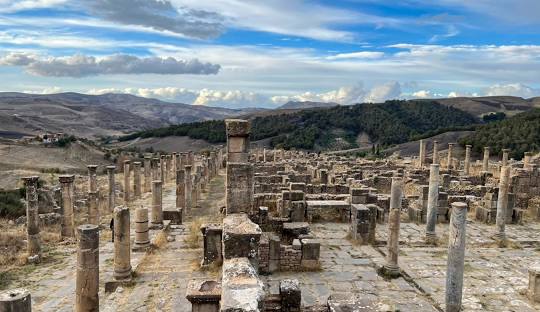Djémila, Algeria
🏛️ Djémila: Algeria's Majestic Roman Legacy in the Mountains 🇩🇿
Perched 900 meters above sea level in northeastern Algeria, Djémila—formerly known as Cuicul—is a remarkably well-preserved Roman city that offers a vivid window into ancient urban life. Designated a UNESCO World Heritage Site in 1982, Djémila stands out for its exceptional preservation and strategic mountain setting.
📍 Location
-
Coordinates: 36.3206° N, 5.7367° E
-
Region: Wilaya of Sétif, Algeria
-
Nearest Major City: Setif (approximately 40 km away)
🏛️ Historical Significance
Founded between 96 and 98 AD during the reign of Emperor Nerva, Cuicul was established as a Roman colony and military garrison. The city flourished between the 2nd and 6th centuries, benefiting from its strategic location and fertile surroundings. Its urban design reflects Roman architectural principles adapted to the mountainous terrain, showcasing a blend of Roman and indigenous Berber influences.
🏺 Key Attractions
-
Roman Forum: A central public space surrounded by monumental buildings, serving as the heart of civic life.
-
Temple of Jupiter: Dedicated to the king of the Roman gods, this temple exemplifies Roman religious architecture.
-
Basilicas: Early Christian basilicas, including a double church complex, reflecting the city's religious evolution.
-
Triumphal Arches: Notably the Arch of Caracalla, commemorating the emperor's visit in 216 AD.
-
Theater and Baths: Well-preserved structures illustrating Roman social and cultural practices.
-
Mosaics and Sculptures: Displayed in the Musée de Djémila, these artifacts offer insights into Roman artistry and daily life.
🖼️ Musée de Djémila
Established in 1911, the museum houses a vast collection of archaeological finds, including:
-
Mosaics: Depicting mythological scenes and daily activities.
-
Sculptures: Statues of deities and emperors.
-
Artifacts: Ceramics, inscriptions, and coins from various regions. The museum provides context to the ruins and is a must-visit for history enthusiasts.
🧭 Travel Tips
-
Best Time to Visit: Spring (March–May) and autumn (September–November) offer mild weather, ideal for exploring the site.
-
Accessibility: The site is accessible via Setif, with road connections to major cities.
-
Guided Tours: Available to enrich the experience with historical insights.
-
Nearby Attractions: Combine your visit with trips to other Roman sites like Timgad and Tipasa.


